Editor’s Note: This story was originally published in The Heat Issue of Life & Thyme.
——
It’s tough to tell if the tufts of steam are coming from subway grates, or from the barbecued chicken being grilled at the hands of mothers and grandmothers on the periphery of the promenade; the sounds of the two blend together into one seamless, sensory composition. It’s an impromptu celebration of a season, one so important to a population perennially battered by brutal winters. Residents relish in the sun they’ve waited so long for; they don’t even seem to mind the stifling heat of a humid, city afternoon. Hip hop sizzles, grills flare, families congregate in observance of nothing more than freedom from their apartments and simple access to fresh air. It’s a vibrant scene—bold and lively, authentically human—authentically Harlem.
When concepting Streetbird, Chef Marcus Samuelsson’s second Harlem-based spot, it was a view like this one that laid the initial track for his vision. “[Streetbird] is very much inspired by what happens in Harlem every weekend in the summertime,” he tells me from inside the restaurant, which opened in 2015. “When you have moms setting up next to big signs in the parks that say, ‘no grilling,’—and it’s the nicest families, barbecuing away. They bring their cousins, they bring some chicken, they have someone DJing and they dance. It’s the most normal thing—they just want to have a party in the park.”
That sun-drenched summer Saturday in Samuelsson’s mind is particularly disparate from the drizzly early spring Monday morning we’re currently subject to. But he paints such a vivid picture, I can practically hear the composed tune of that party, its signature sound and style.
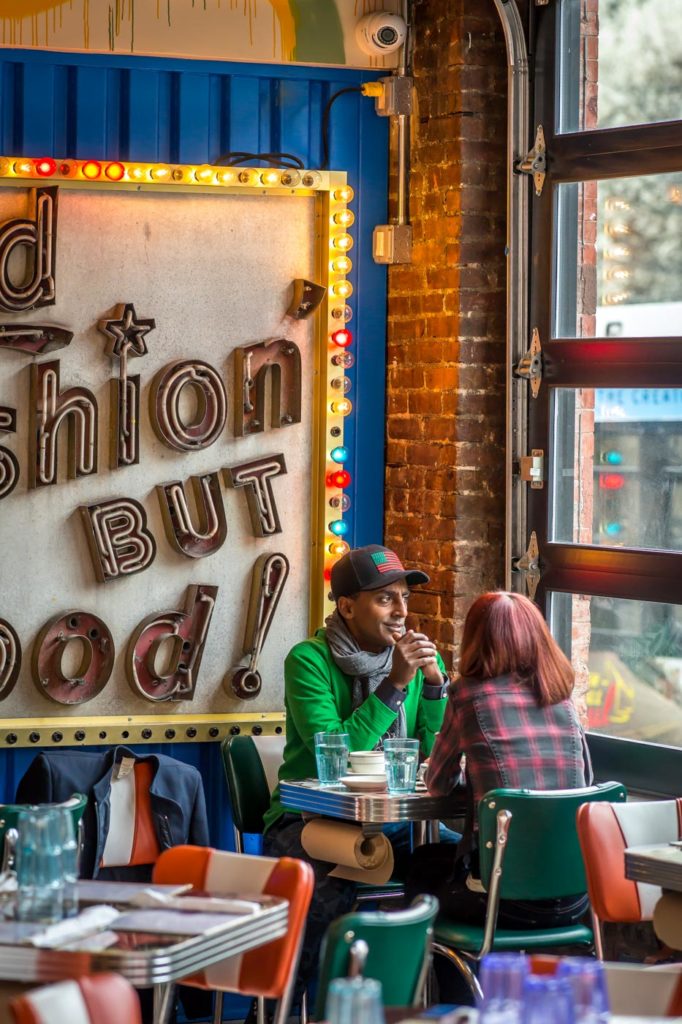
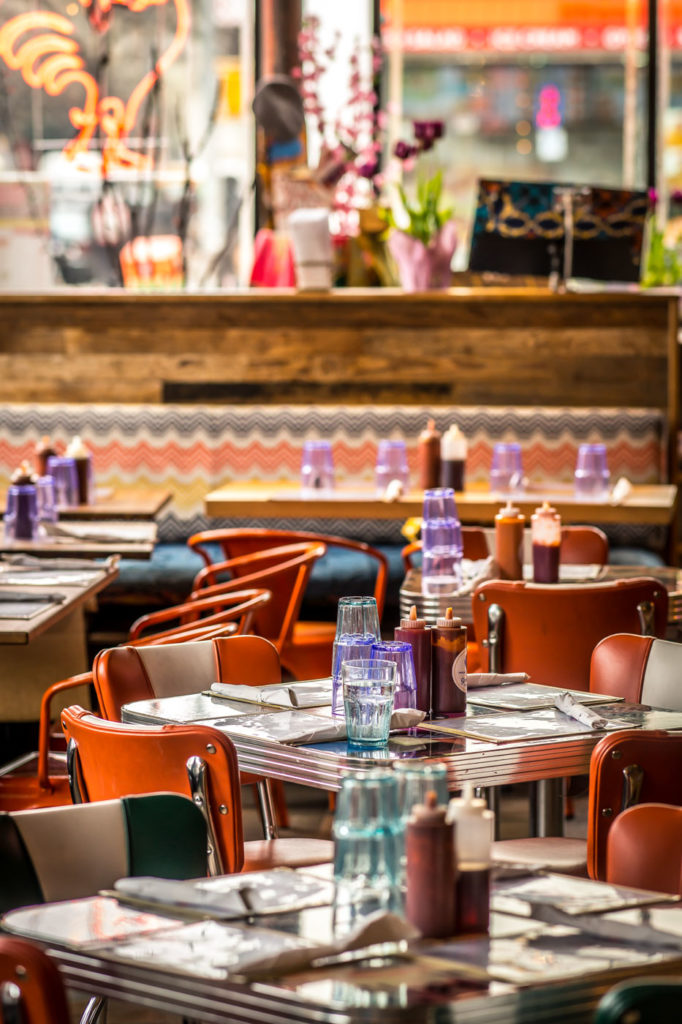
New York City is sensory overload in all the best and worst ways; there’s always something to see or smell, to touch or be touched by (or to avoid touching altogether). And for those in tune—those who really listen—there is always something, or someone, to hear. Sounds of the city, songs of its past, voices of its people—all manifested in so many ways.
On this drab morning, the Harlem sound is muted; but still, it’s dynamic. Percussive tamps of rain pelt plastic trash can lids; the timbre of taxi tires that peel through rainwater luges lining the roadways fades in and out. The syncopated rumbling of the subway below lays a structural bass line, and the train’s halting hiss belies the distorted, reverberating riff of kneeling city buses above. As I emerge from the B train and ascend to street level, it stitches together into a crescendo—the steady heartbeat and swelling song of the city’s northern neighborhood.
And if Harlem has a pulse, you’d most certainly find it thrumming beneath Samuelsson’s perceptive thumb. Following the success of his first restaurant, Red Rooster, Streetbird is Samuelsson’s sophomore effort, on the corner of 116th Street and Frederick Douglas Boulevard. Full-wall windows offer unobstructed views onto both corridors, and it’s a perch where he can keep watch on the locale for which he has become a willing ambassador.
When I’m introduced to the notoriously stylish chef, he lives up to his fashionable reputation; his recognizable, slim frame mirrored by a slender, sour cherry necktie and striking green hoodie the color of its would-be stem—as complementary as a fresh mint leaf—accessorized by an expertly paired black ballcap bearing the green stars and red stripes of a bizarro American flag. He manages to maintain functionality, wrapped in a coordinated, weather-appropriate scarf, and suddenly I find myself feeling exceptionally unhip by comparison.
In meeting Samuelsson, and in getting a good look around Streetbird, bold is the word I find reprises in my mind. It’s all reflective of a man who makes bold moves, both in style and substance.
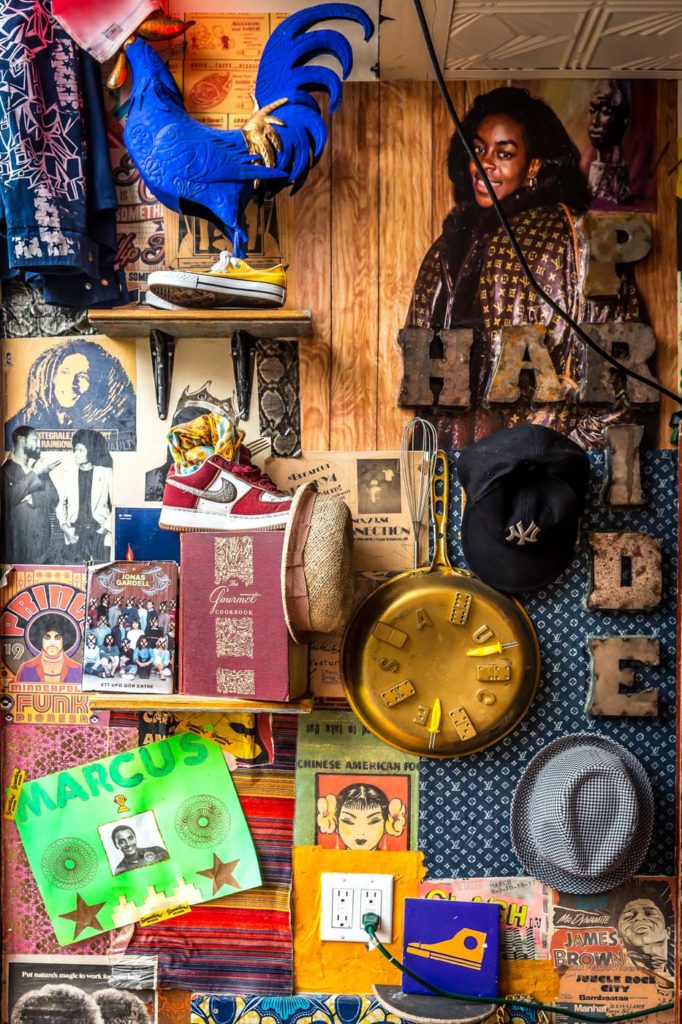

The restaurant’s decor is a curated collection of pop culture artifacts; boom boxes collect around columns, skateboard decks function as seatbacks for dining chairs, cassette tapes find a new life as light fixtures. The open kitchen gives a glimpse into the dish pit, which is housed beyond two repurposed subway doors permanently in the open position—no need to stand clear.
And yet we don’t sit at the bar in view of the kitchen, nor at the diner-style counter where a small pedestal promises Hummingbird Cake once doors open for service. Instead, we sit in a window on the 116th side, with Samuelsson’s back to the wall and facing 8th Avenue, where he can listen closely to the symphony of the streets surrounding his restaurant.
The boldness is accordant, too, with the aroma and appearance of the dishes being plated and tabled nearby—the first a take on chicken and waffles; the latter being an eye-popping variation in red velvet form. Another—the “notti greens”—is spiked with piquant red chilis. Like the chef himself, the plates have style. Each is distinctive and unique, not one nearing derivative territory—but they’re also not so far-reaching that diners won’t sense their familiar soul. It’s old fashioned comfort food culled from careful study of a cadre of cultures.
And then arrives the “The Hot and Messy”—a custardy slice of cornbread topped with peanut butter, avocado, bacon and a fried egg. It’s become challenging in today’s experimental food culture to find something that sounds so, well, out there—but with the first bite, I can’t believe this thing isn’t on menus across America. Not only is it not strange, it’s downright comforting. Sweet corn and salty peanut butter, with a viscous yolk dressing tender rotisseried chicken and countered by the friendly smokiness of bacon—the thing has flavor. It’s like the now-nearly ubiquitous avocado toast, but with serious attitude. And it’s basically all I can do to not dive in mid-shot.
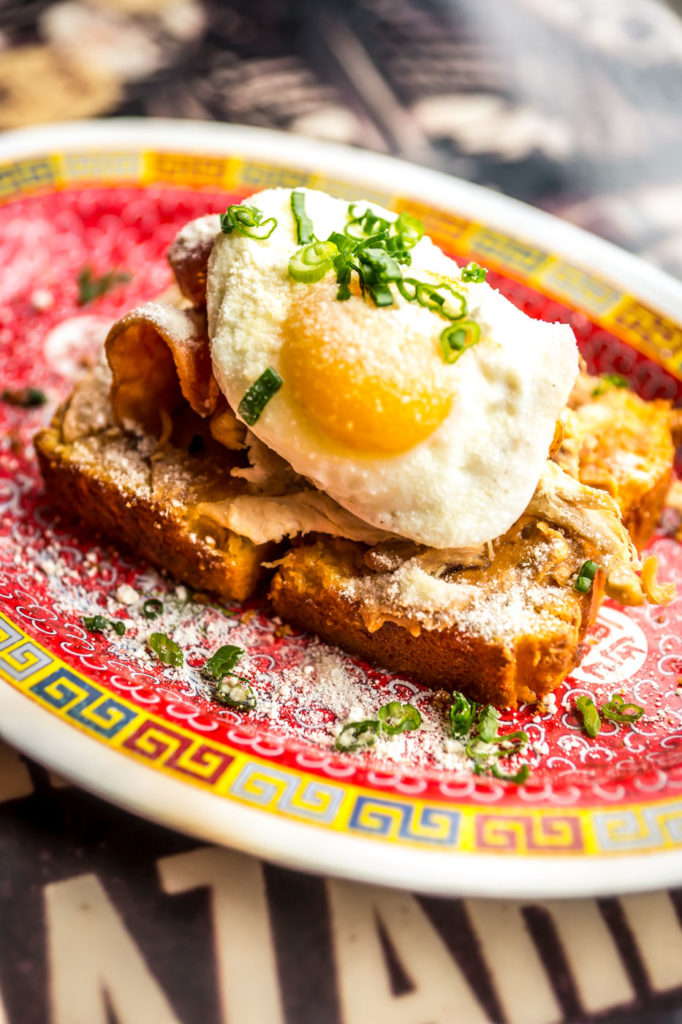
Fortunately, having a conversation with the chef is as compelling as tasting his compositions. Samuelsson spends much of our conversation looking out the window, rarely making eye contact, and scarcely distracted by the operations of his restaurant—like many chefs so often are. But never do I feel as if he’s disengaged. Quite the opposite, in fact. His confidence in his well-trained staff leaves him freedom to think things through—to give our conversation his full attention. There’s a sense that he’s deeply considering each question, every statement an implication for not only his restaurant, but his community and friends—the neighborhood band of which he’s been appointed front man.
Harlem may be less than four square miles, but Samuelsson describes global representation within its boundaries and along its boulevards. There’s a sense that despite having cooked all over the world, the confined one in which Streetbird sits is just as much—if not far more—complex and exciting to him. He sings the praises of the neighborhood, and that tune is pretty damn catchy.
“You sit at counters where everyone knows what to order. Coffee is café con leche, and no one gives a shit where the beans come from. There are no beards. There’s no angst,” he laughs, a harmless nod to a recently acquired collection of hipsters now calling Harlem home. “Mom is serving you, and it’s fast, and the food is flavorful. And it’s hot sauce, or it’s hotter hot sauce. And if you’re doubting, she’s going to the next person. If you’re sitting at this counter, you better know what’s going on—it’s a rhythm. It’s a tempo.” In fact, the way Samuelsson describes the scene has a cadence all its own. “No one would ever think about Instagramming shit like that—it’s just happening. I love that.”
The chef is referring to a type of dining spot common in Puerto Rican parts of town, but he never breaks his flow as he switches tracks from one cultural exploration to the next, as seamlessly as a needle between grooves. “You go to the Mexican place and it’s fantastic. And they’re setting up outside delis, and you get [to eat] feet and tongue—and it’s basically food for the Mexican person who goes to work before the subway or the bus.” It’s with the same analytical conviction that he’s investigated all cultures of his adopted borough—with the same admiration regardless of genre. “If you don’t understand that, you might miss it. And it’s fantastic.”
Discussing the inspiration for his menus and the style of his restaurants, it’s clear that each plate is a story told through the topography of the territory, distilled through a chef who considered not only the flavor of a dish, but each demographic that contributes to Harlem. It makes his menus truly reflective of their communities—based not only on local ingredients, but on locals themselves.
In fact, he talks so much more about people and culture than cuisine it’s hard to tell whether the man is a chef or an anthropologist. That is, of course, until the food arrives, proof that he’s equally accomplished at both the academic and the edible. But by the time we’re finished, my head is spinning with the dizzying depth of Harlem’s history and arrangement.
“When I look at Harlem, I can really break it out,” Samuelsson gestures illustratively. “The east side was all Puerto Rican, Jewish and Italian. Today, it’s largely Mexican. Central Harlem was largely African American—it still is—but it’s also sprinkled in with Caribbean, and young families from all over the world. We’re actually in the middle of Little West Africa [here].” Samuelsson considers Harlem to be a self-contained but authentic reflection of larger patterns. “What happens in the world, happens here. For me, here and at (Red) Rooster, we follow immigration—and we follow global immigration.”

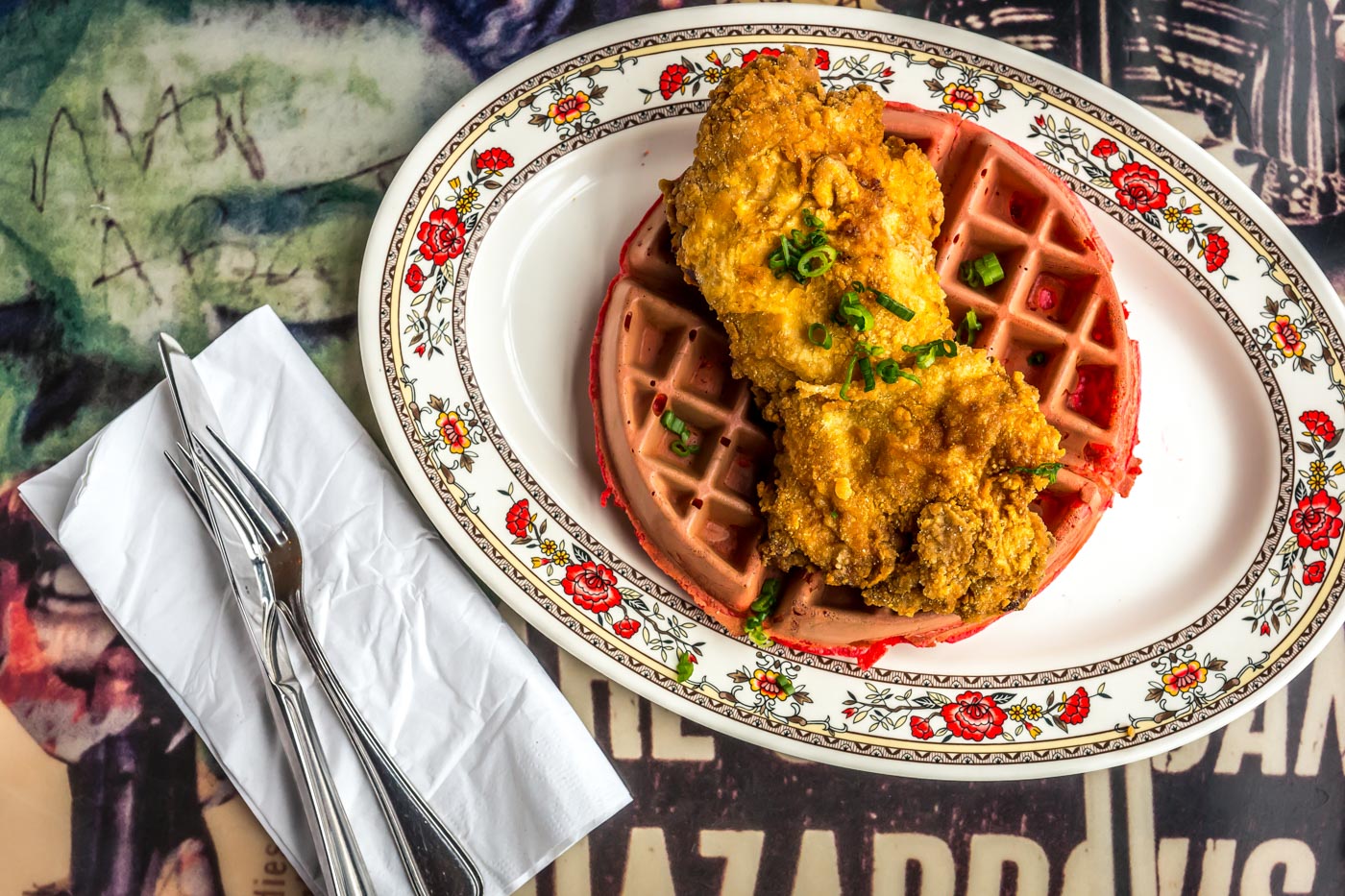
By now, it’s pretty common knowledge Samuelsson himself is no Harlem native. He was born in Ethiopia and raised by adopted parents in Sweden. But the feeling of being American was never foreign to him; his passion for music served as an entryway into the States.
“I think in one way I’ve always been American. The world I grew up in, we were always of America in a weird way,” he explains. “Because of MTV and because of pop culture—and music was definitely the window into pop culture—I never separated music from America.” Looking out the window into undeniably American streets in his starred, striped ballcap, Samuelsson finishes. “I’m American now, but it was a journey to become an American.”
Those things—music, American pop culture from Samuelsson’s youth—are well represented in the environs of Streetbird. It could be referred to as retro, even nostalgic. But there’s nothing contrived about it. Samuelsson himself curates and collects much of the decor; which, rather than simply satisfying a throwback aesthetic, is intended to create deeper conversations. The intergenerational influences intended to be unifying rather than divisive.
Samuelsson motions to a boom box tower. One of the aluminum clunkers looks a lot like one my dad had in the garage when I was a kid; I used it to play mix-tapes recorded from the radio. I can’t say I’ve seen one since. “A lot of kids come into today with their parents, and they don’t know what the cassettes are; they don’t know what a boom box is, so it becomes a talking point.” Samuelsson subtly shapes tableside conversations, furtive efforts to return authority to the adults. “Then mom and dad can actually be the cool ones, explaining [to their kids]. Because when you have this [points to the iPhone between us], it’s always the kid explaining to mom and dad. This switches the dialogue.”
In divulgences like this, Samuelsson makes it evident that everything in his world is deliberate. No detail is simply decorative—no decision cursory. Nothing inside Streetbird or about the chef’s career is without story and careful consideration; so it’s no wonder he says it took considerable time to develop his concepts. “I’m pretty slow,” he admits. “I studied Harlem for five years before I opened the restaurant. Moving up here with Rooster in mind, I had to take [that time] to think about what it was. For me, it was very clear that photography, art, music, church—led to my food; it wasn’t vegetables, fish, dot, dot, dot. It was these things—people—that congregate in church, music—that lends to Harlem. And that led to the food and to our hospitality. I was constantly thinking about how much of that do I bring in here?” And it was the answer to that personal inquiry that resulted in the menu of his first restaurant. “My food from [Red] Rooster was very inspired by what was all here. I [just] put four walls.”
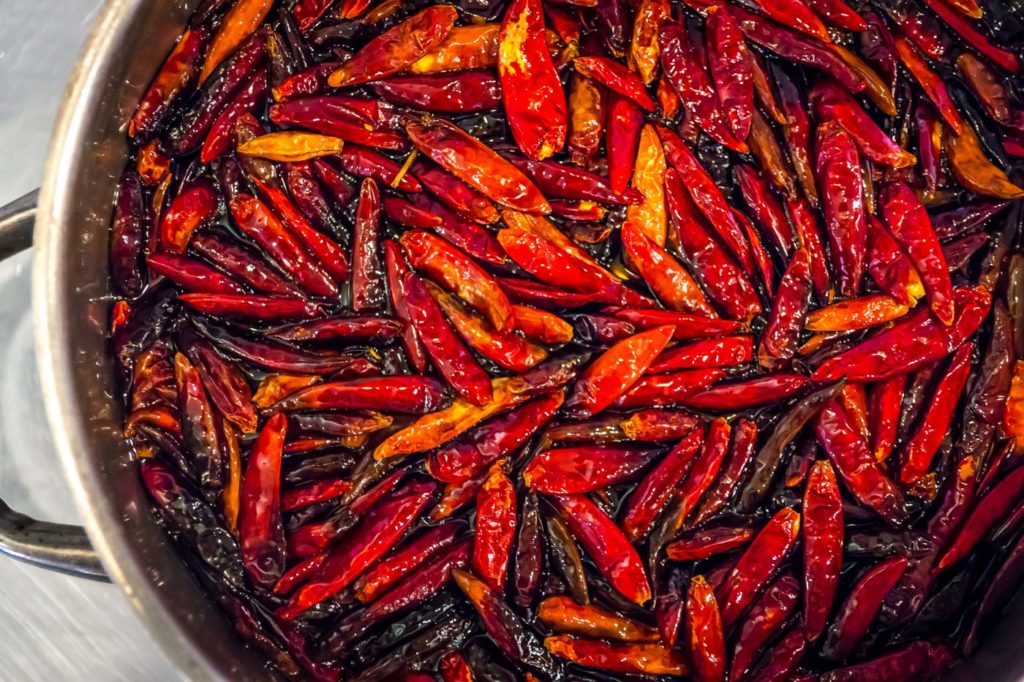
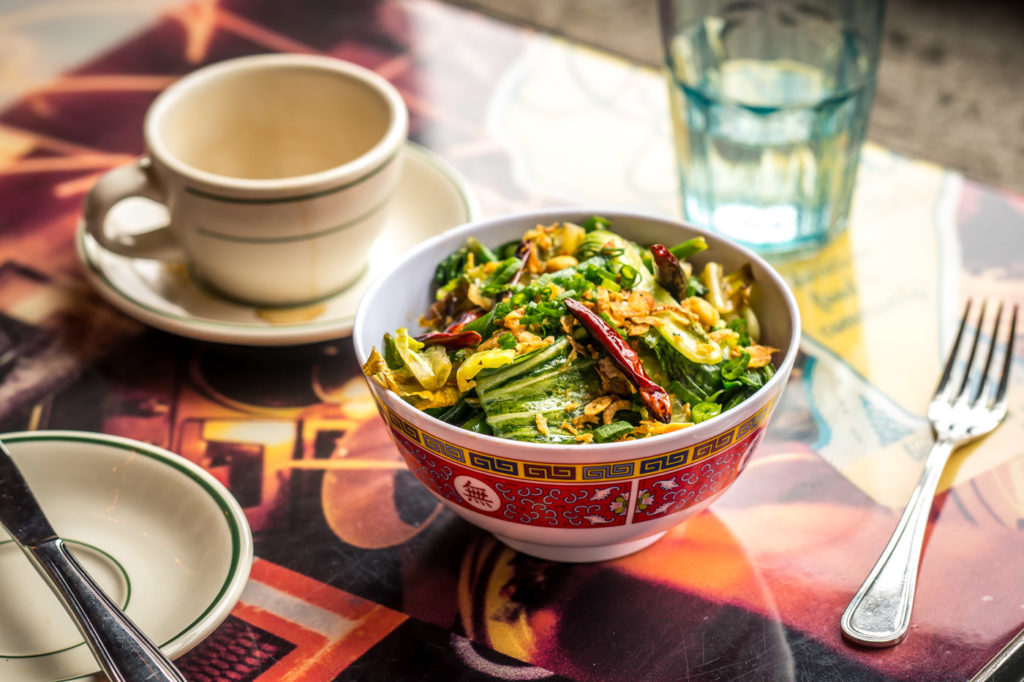
In Harlem, Samuelsson has found no shortage of inspiration. He’s eager to share the research he collected during that time, educating on culture through his cuisine. “Here, the Jamaicans and Caribbeans and West Africans have been huge in the food scene. Huge! The black cooking that people know of—the chicken and waffles—that’s the food we know of when we think about Harlem.” He goes on to describe the development of Southern food (the influence of labor and African ingredients), differences between the meals of the haves and the have nots (“[Both] ate pretty much the same—the grits were the same, the collards were the same—except the protein; the wings went over here and the breast went over here”), and draws again on music to support his description of its diversity: “[It’s] very similar to how jazz was created. It’s got one base, but then a lot of things added into it.”
And like any good musician knows, timing is everything. He didn’t immediately move to Harlem upon arriving in New York. Samuelsson serendipitously discovered the neighborhood at a time along his own American journey when he was based in Manhattan and working in kitchens, but his mind was beginning to open up. “I think it’s wherever you are in life. At that point, I had just discovered my Ethiopian roots and was introduced to the tribe I came from, and how thick the tribal-ness was.”
A hunger for community and social support was surfacing for him. “[It was] this time where I was actually looking for a neighborhood, versus just going to work and coming back [home],” which he recalls was the structure of his routine at the time. “I think it helped that I came from Midtown and I didn’t know my neighbors at all,” he recalls. “If I had come here 10 years earlier, maybe I wouldn’t have been open to that.”
Samuelsson respects the metronome of his metropolitan experience, and the instrument that time can be in developing an idea. Once in Harlem, the time that he took was in part so he could determine how to add to the culture of the city rather than simply adopt it, which meant understanding the neighborhood’s nuances—right down to the building in which Streetbird lives. “If you study this building, it’s had a very funky past. Most of the drug trade was 8th Avenue; this very building was a crackhouse,” he says. “For me, it’s very important to turn something that had one history into something else. To nourish it. That is activism.”
Enriching the community meant more than creating culturally recognizable dishes; it meant making them accessible too. “I think about what doesn’t Harlem have. Amenities in urban communities are a big deal. We didn’t have delivery—and why should the delivery experience be different south of 96th Street?” Samuelsson questions. “A single mom with two kids—why should she not be able to get [delivery]? That’s just a civil right to me. I’ve traveled and seen things. I know it’s possible, and we want to make those things happen.” Access to food is part of Samuelsson’s push for an overall shift in paradigm. “For us, to be able to deliver food—let’s provide that in an affordable package. If you’re going to ignore us, then ignore us. I’ll figure out how to work around that—that’s part of being on that different grid.”
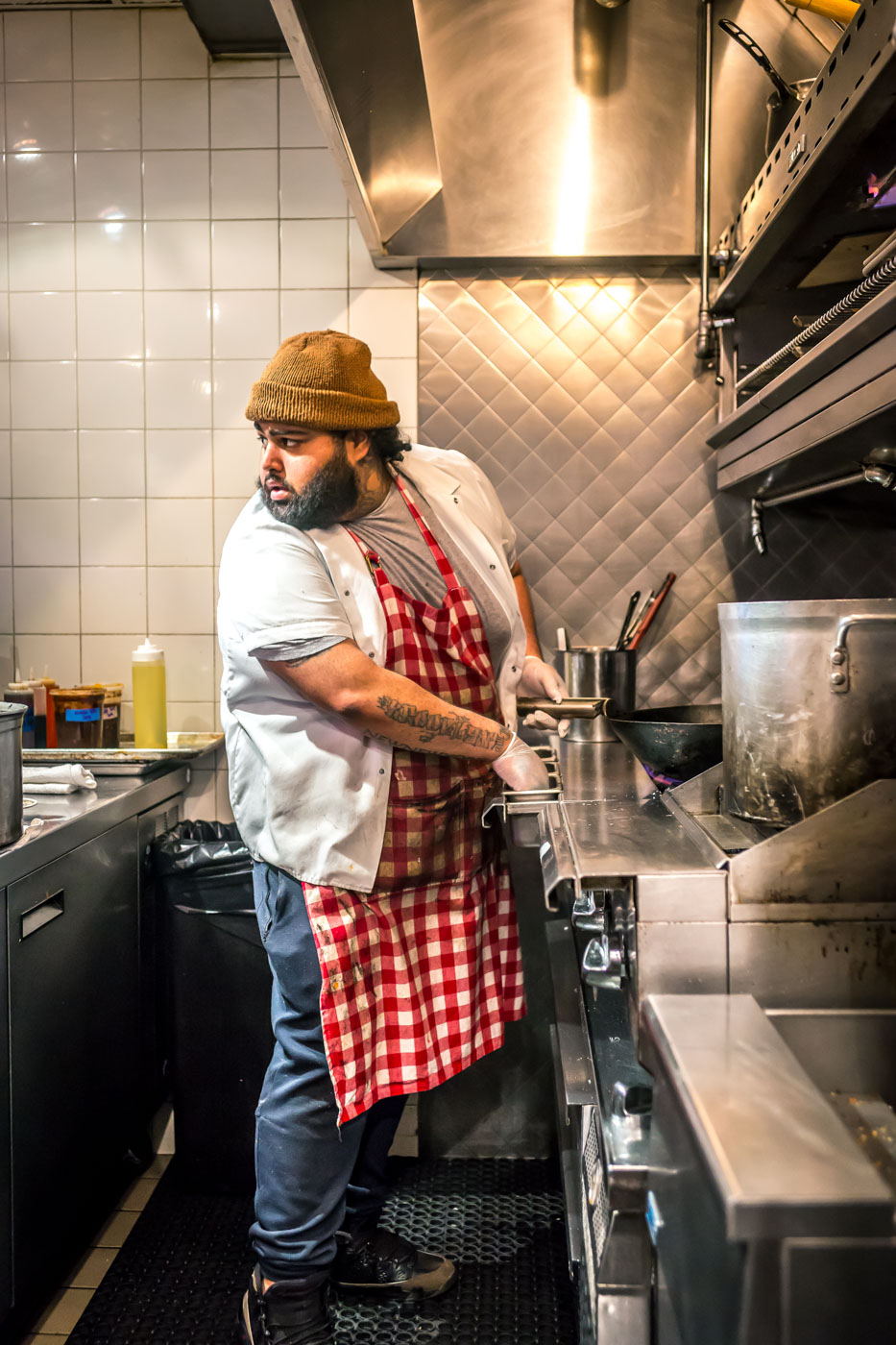
Samuelsson means recognizing limitations, but not settling within them. “As a black man living in Harlem, it’s very clear that you have to create your own grid—which for me is very punk to begin with. As a black person, it’s even clearer that there’s nothing meant for you. And that’s either a problem or an opportunity. You can dwell on this, but it can also give you clarity. Nothing is made for you; you better go and create your own grid.” These parameters invite innovation, according to the chef.
The ability to have dinner arrive on a neighbor’s doorstep is only one stride. Developing a business that supports and employs its residents, nurturing talent rather than importing it, is another. “Each chef is taking a stand by being a food entrepreneur, which essentially means you’re having a dialogue with your neighborhood.”
Even the etymology supports Samuelsson’s ideals. “Go back to the word restaurant—it means to restore a community. We have 200 employees. That work is here. The great thing with restaurant work is most of [it] cannot be outsourced,” he explains. “You’re saying to that neighborhood, ‘You can get a job here. Your daughter can get a job here. You don’t have to get on the subway and go get a job downtown.’” Samuelsson believes that efforts like this are the ones that affect real change; “That is activism at its core.”
And this sums Samuelsson up. He is, of course, a chef, but he’s as much an activist; food is a plated entry point to larger conversations.
And while he aims to create rather than export jobs, he hopes to import more guests and increase interest in the community that has set the tone for his life. His restaurants have created a draw to an area perhaps otherwise neglected by certain populations. In an effort to maintain and build upon that excitement, Samuelsson co-founded a food and culture festival called Harlem Eatup, which features chef and artist participants from around Harlem and the globe.
“[The festival] activates all of Harlem,” Samuelsson is leaning in on his elbows now, describing the project as his staff sets up for service. “I really want to add something to tourism. Don’t just get back on the bus—no, no. Hang out. Hang out the way you would on 23rd Street. Treat this community the same. There’s a tamale shop down the street. There’s a coffee shop,” he points out the window. “Hang out,” he repeats. “Discover! Discover music, art, food.” He identifies with the city in this way. “My narrative is through this stuff. That’s how we work.”
Admittedly, although I lived in New York City for years and grew up visiting frequently, I’d never been to Harlem until today. Hell, I probably hadn’t been above 86th Street more than once or twice. After I thank Samuelsson and snag a few more bites of Streetbird’s Hot & Messy to fortify myself for the rain, I step out of Streetbird toward the Harlem intersection.
I start making my way to 8th Avenue to hail a cab—back downtown, back to the part of the island most familiar to me. But then I hear Samuelsson’s refrain: Hang out. Discover. The rain stops and the clouds part briefly enough to invite the sun. I watch a few Streetbird employees arrive. I let a lit cab pass by, and then another. I hear music in the distance, and suddenly I can clearly imagine that summertime scene. I start to isolate the sounds of the city; a rhythm manifests; it’s Harlem’s heartbeat—a thumping, thrumming, thriving pulse by which the chef, restaurateur and activist draws his inspiration.
Samuelsson’s efforts make him a thoughtful troubadour in a time when food is frequently about flash. He listens where other chefs often shout. Through his efforts—between himself and his neighborhood, his restaurants and their guests and respective staff, the cultures in each enclave and the cuisines that help draw those crowds—Samuelsson has created harmony in Harlem. He’s harnessed the voice of the neighborhood—and he’s gently turning up the volume for the rest of us to hear. From my fresh vantage point, it’s worth a listen.
——
Streetbird
2149 Frederick Douglass Blvd, New York, NY 10027





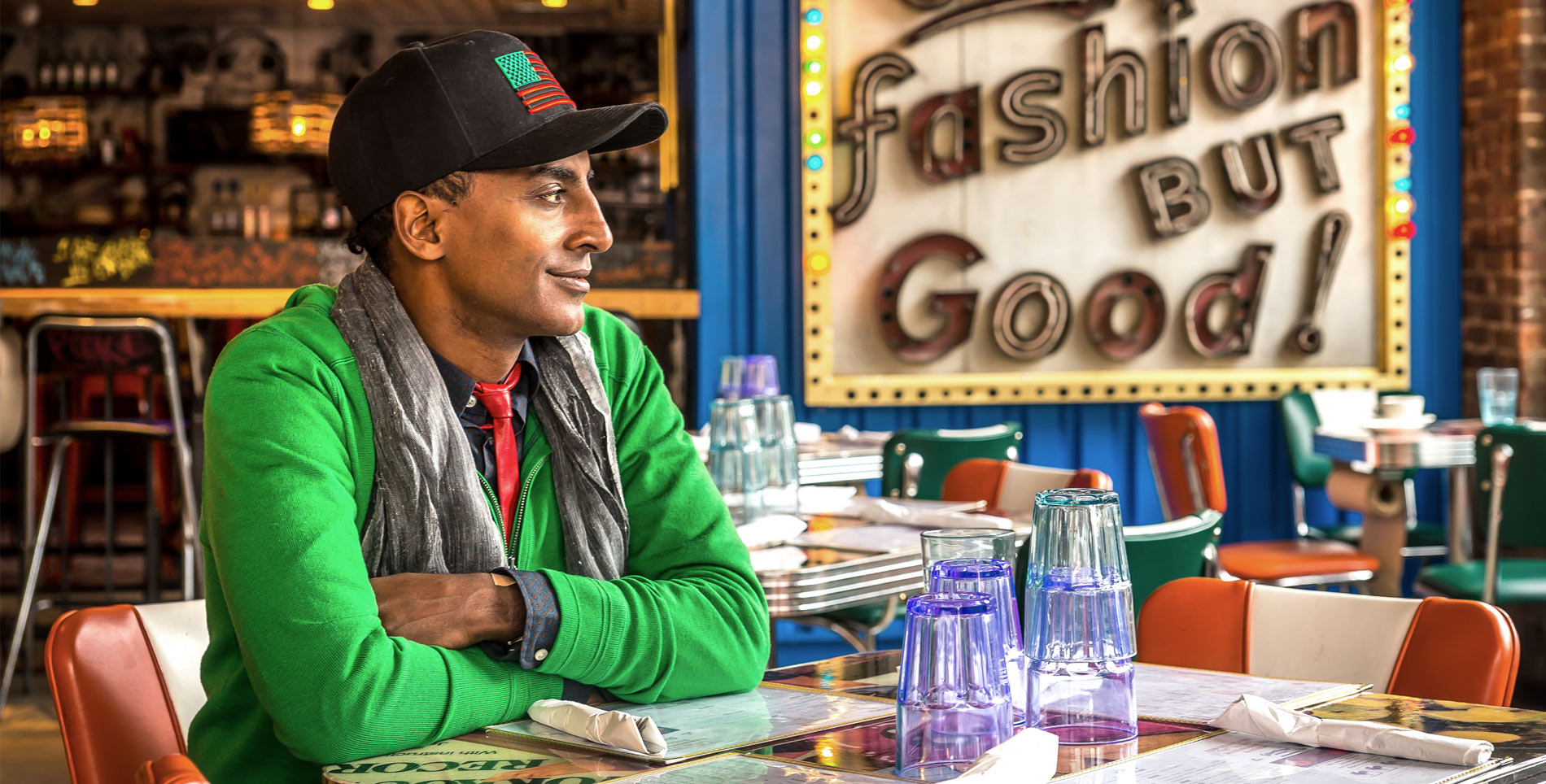

Our comments section is for members only.
Join today to gain exclusive access.